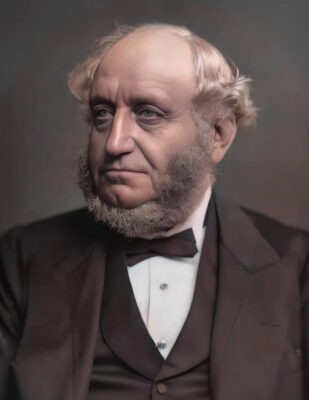The Story Behind: Crown Him With Many Crowns
Crowns are more than decorative headwear reserved for royalty. They signify honor, power, and dominion. For the King of Kings, a single crown could never suffice to represent His infinite glory and authority. And so we “Crown Him with Many Crowns” as we lift our voices to praise the One exalted high above all others. This beloved hymn magnifies Jesus, the Lord over all creation deserving of every crown. The lyricists beautifully capture just some of the many facets of our Savior’s majesty that demand our worship. As we sing, we join the eternal chorus around God’s throne, proclaiming the wonder of who Christ is and what He has done. The rich imagery stirs our hearts to offer Him every crown, for no earthly treasure compares to the treasure we have in our risen, glorified Lord.
Matthew Bridges Writes Original Lyrics Inspired by Revelation
The hymn Crown Him with Many Crowns was written in 1851 by Matthew Bridges, an Anglican minister who later converted to the Roman Catholic Church. Bridges was born in Essex, England in 1800 and pursued literary interests in history and poetry. He was influenced by John Henry Newman and the Oxford Movement, which aimed to reconnect the Anglican tradition with ancient Christian history and liturgy. This led Bridges to convert to Catholicism in 1848.
Bridges wrote the original six stanzas of the hymn after being inspired by the “exaltation and many crowns of Jesus” described in Revelation 19:12. The lyrics reflect on the different roles and honors of Christ, referring to Him as the “Lamb upon His throne” and “Son of God” who wears “many diadems.” Bridges used rich biblical imagery like “eyes are like a flame of fire” directly from Revelation to capture the majesty of Jesus.
Godfrey Thring Adds New Perspective in Verses
In 1868, Anglican priest Godfrey Thring wrote additional verses while serving at St. George’s Chapel in Windsor castle.
Born in 1823, Thring spent his life in dedication to the Church of England. As a Protestant minister, he brought a different theological perspective than Bridges’ Catholic lyrics. Thring’s new stanzas broadened the hymn’s vision by focusing on Jesus as the “Lord of life,” “Lord of love,” and “Lord of years” – bringing out more perspectives on Christ’s eternal nature and lordship.
Condensed Version in Modern Hymnals
Though the original hymn contained a total of 12 verses, 6 by Bridges and 6 by Thring, most modern hymnals today only include 4 selected verses. These 4 widely used verses – “Crown him with many crowns,” “Crown him the Lord of life,” “Crown him the Lord of love,” and “Crown Him the Lord of heav’n” – provide a condensed but still rich vision of Christ’s lordship and exaltation. The popularity of the hymn led to mixing and reduction of the original 12 verses down to these 4 accessible stanzas that continue to inspire worship and praise in churches today. Though not comprehensive, the shortened version retains the celebratory spirit and vital imagery of the full original work.
Elvey Composes Acclaimed Tune DIADEMATA

The tune DIADEMATA was composed in 1874 by Sir George Job Elvey, a prominent English organist who served the royal family at Chapel Royal. His tune perfectly captures the celebratory, march-like spirit of the lyrics.
Music scholar J.R. Watson described DIADEMATA as a “magnificent setting for the text, march-like and joyful without ever becoming mechanical or strident.” Elvey’s contribution of the memorable tune helped cement the hymn’s lasting prominence.
Enduring Popularity Across Denominations
Despite their theological differences, the joint work of Bridges, Thring, and Elvey produced a rich hymn of praise that has inspired Christians across denominations for over 150 years. The song appears in the hymnals of Baptist, Methodist, Anglican, and Catholic traditions.
Sung during holidays like Christmas and Easter, the song magnifies the Kingship and sacrifice of Christ. The imagery and music unite to create a royal hymn of worship exalting the risen Lord Jesus.
The Six Crowns of Christ
The lyrics of Crown Him with Many Crowns touch on six different crowns that represent various aspects of who Christ is and what He has done:
The Crown of the Lamb Upon the Throne
Crown Him with many crowns, the Lamb upon His throne, Hark! How the heav’nly anthem drowns all music but its own! Awake, my soul, and sing of Him who died for thee, And hail Him as thy matchless King thro’ all eternity.
This first crown signifies Christ’s position as the Lamb of God exalted upon the throne in heaven, worthy of eternal praise. “Then I saw a Lamb, looking as if it had been slain, standing at the center of the throne.” (Revelation 5:6)
The Crown of the Son of God and Son of Man
Crown Him the Son of God Before the world began, And ye, who tread where He hath trod, Crown Him the Son of man; Who every grief hath known That wrings the human breast, And takes and bears them for His own, That all in Him may rest.
The second crown reflects Christ’s dual nature as both fully divine and fully human, able to redeem mankind. “In the beginning was the Word, and the Word was with God, and the Word was God…The Word became flesh and made his dwelling among us.” (John 1:1,14)
The Crown of Love
Crown Him the Lord of love: behold His hands and side, Rich wounds, yet visible above, in beauty glorified. No angel in the sky can fully bear that sight, But downward bends his wond’ring eye at mysteries so bright.
The third crown embodies God’s love demonstrated through Christ’s sacrificial death to save humanity. “But God demonstrates his own love for us in this: While we were still sinners, Christ died for us.” (Romans 5:8)
The Crown of Life
Crown Him the Lord of life! Who triumphed o’er the grave, Who rose victorious in the strife for those He came to save. His glories now we sing, who died and rose on high, Who died eternal life to bring and lives that death may die.
This crown represents Christ’s power over death through His resurrection, granting eternal life. “Jesus said to her, ‘I am the resurrection and the life. The one who believes in me will live, even though they die.’” (John 11:25)
The Crown of Peace
Crown Him the Lord of Peace, Whose power a scepter sways From pole to pole, that wars may cease, Absorbed in prayer and praise; His reign shall know no end, And round His blessed feet Fair flowers of paradise extend Their fragrance ever sweet.
The fifth crown depicts Christ as the Prince of Peace, reconciling mankind with God. “For he himself is our peace, who has made the two groups one and has destroyed the barrier, the dividing wall of hostility.” (Ephesians 2:14)
The Crown of Heaven
Crown Him the Lord of heav’n! One with the Father known, One with the Spirit thro’ Him giv’n from yonder glorious throne. To Thee be endless praise, for Thou for us hast died. Be Thou, O Lord, thro’ endless days adored and magnified!
Finally, the sixth crown exalts the ascended Christ as Lord of Heaven, bestowing eternal life on the redeemed. “After he said this, he was taken up before their very eyes, and a cloud hid him from their sight.” (Acts 1:9)
Background on Bridges and Thring
Matthew Bridges and Godfrey Thring were both 19th century English ministers in the Church of England, though they came from differing church traditions and did not know each other personally.
Bridges was born in Essex, England while Thring resided nearly 100 miles away in Windsor. The two men wrote their verses independently, separated by over 20 years. Bridges penned the original lyrics in 1851, while Thring wrote six additional stanzas in 1874. There is no record of them ever meeting in person or collaborating directly on the hymn.
As an Anglo-Catholic, Bridges was influenced by medieval church history and liturgy, inspiring his use of Greek and Latin hymnody. Thring served at Windsor’s St. George Chapel, immersing him in British royal heritage and shaping the kingly metaphors in his lyrics.
Though the two men never met and came from differing backgrounds, the joining of their lyrics after their deaths allowed Christians from many denominations to find common ground in this rich, popular hymn praising Christ the King with lyrics reflecting on the many crowns and diadems of Jesus. Elvey’s musical setting for the hymn composed while he served the royal family as organist at the Chapel Royal makes a magnificent, march-like accompaniment influenced partly by John Henry Newman’s impact on 19th century English hymnody.
Frequently Asked Questions (FAQ)
Q: Why does Jesus have many crowns?
A: In the hymn “Crown Him with Many Crowns”, Jesus is pictured as wearing many crowns. This imagery stems from Revelation 19:12, which describes Christ having “many diadems” on His head. The word diadem is an old term meaning crown. The multiple crowns represent the many different roles, honors, and powers that Jesus possesses. He has crowns of dominion as King over all creation, crowns of love for sacrificing Himself for humanity, crowns of resurrection for conquering death, and crowns of peace for reconciling man to God. No single crown could ever fully encapsulate Jesus’ infinite authority and glory. That’s why we “Crown Him with Many Crowns” – because our Savior deserves every crown for who He is and what He has done. The many crowns exalt Christ’s supremacy as the risen Lord of lords.
Q: What do crowns represent in the Bible?
A: In the Bible, crowns are symbolic of power, victory, honor, and royalty. When Jesus is crowned, it represents His authority and kingship over all creation. Specific crowns mentioned in Scripture include the crown of life (James 1:12), righteousness (2 Timothy 4:8), glory (1 Peter 5:4), and rejoicing (Proverbs 14:24). 1 Corinthians 9:25 refers to an imperishable crown awarded to those who overcome trials. Revelation 19:12 describes Jesus with “many diadems” representing His supreme sovereignty. So crowns in general signify righteous dominion, while Jesus’ many crowns point to His infinite reign as risen Lord of lords.
Hymncharts offers two different arrangements for Crown Him With Many Crowns (the first can be heard as the soundclip at the top of this page, the second can be heard in the lyrics video at the bottom.) Download sheet music, chord charts, tracks, multitracks and instrumental parts exclusively with a hymncharts subscription. You won’t find this arrangement on any other website.


